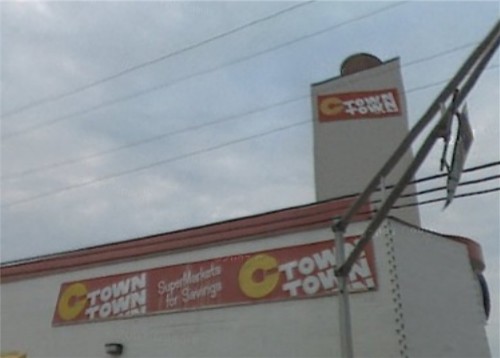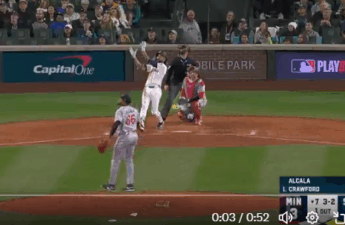Today I decided to try somewhere that wasn’t Stop-N-Shop for my what is apparently becoming bi-weekly grocery trip. This meant heading back over the Raritan into New Brunswick to check out C-Town, which would have been the local place to buy food had I wound up in any number of apartments I sought in NB before winding up in Highland Park instead. When I’d passed it a couple times doing exploratory walks to go with apartment visits, it had seemed a friendly enough place, bustling with young families and the like.
If you’ve never heard of Stop-N-Shop or C-Town, don’t be surprised. (I had never heard of the latter till discovering this locale.) For some remarkable reason, grocery stores seem to be one of the only commercial enterprises in America that resists nationwide consolidation into mega-chains. Sure, the somehow unrelated Wal-Mart and Walgreens have started selling food and getting into the action, but there is no universal grocery store chain. I grew up with Safeway and Albertson’s, only to discover upon moving east that these were unheard-of there. When I moved to New Mexico, entirely foreign names like Smith’s and Jewel Osco entered my lexicon. It seems entering a new part of the country always means discovering at least one completely unknown chain, such as when we drove to Maryland with Fish last year and came upon a cluster of Food Lions. Food Lion? Are you kidding me? The first five times he said it, I thought Fish was saying “Food Line“, which was a hilarious enough name for a grocery store without being the complete non sequitir that is the king of the food jungle.
Anyway. I get over the river, hang out at Chipotle, almost ask a girl in line out before I remember what my personality actually is, then head down to C-Town. Why it is called C-Town, I have no idea, but one theory that dawns on me as I enter is that the “C” stands for “convenience”, because this place doesn’t really look like a grocery store from the inside. The shelves are too small, the aisles too crammed, and the proportion of overpriced junk food too high. Needless to say, the clientele is also decidedly more down-to-earth and desperate than at the Highland Park Stop-N-Shop. The predominant language within is Spanish and the prices are… higher. Yes, higher for the poor folks in the poor neighborhood than in the spacious overlit aisles of the place across the river.
I don’t want to hear your economic arguments or your bias or your justifications or your excuses. I know that you could say that they have a higher risk of shoplifting to absorb, or have to guard better against break-ins overnight, or lose more carts on average than the swankier uptown place. If this were a debate round, I could come up with 12 good arguments to justify the higher prices in the poorer part of town too. But the bottom line is that, while it might not be C-Town’s fault per se, the fact that these realities exist, and are legion and provable, means that most people’s economic theories about escaping from poverty are bunk.
There’s a Shell station in Oakland that always has consistently the highest prices for gas, possibly in the entire state of California. We used to pass the place on the way to the Mexicali Rose quite frequently and would joke and laugh about what the astronomical figure would be today, continually flabbergasted that our outlandish predictions would always be trumped by the numeric reality before us. It goes without saying that this was in about the worst part of town we actually drove in when not looking for runaways from Seneca.
The problem is that the poor don’t have the mobility to get out of their neighborhood. Most everything has to be close because they are the least likely to have cars and spare time and the money to use public transit. And when grocery stores are really just slightly larger but still overpriced “convenience” stores, they get locked into choices that are less healthy and less auspicious, yes, but especially more expensive. Which means that the marginal dollar on necessities goes further for the rich than the poor. Making groceries an objectively regressive commodity in our society. Which would be less problematic if groceries weren’t, oh, the most essential commodity for people to buy in this society.
Yes, there are food stamps. But I’m willing to guess most of the Spanish-speakers in C-Town don’t have much access to food stamps or someone to explain to them how to get them. And the marginal cost still applies, for food stamps are priced by dollar of cost and not by nutritional value of item. So you’re still better off having food stamps at the HP SNS than the NB CT, if you’ve even been given access. Of course those close to the HP SNS are much more likely to have said access.
There’s a legion of documentation on the web about this phenomenon and how most poor neighborhoods (e.g. the Tenderloin in dear old SF) don’t have any grocery stores at all, driving the marginal dollar into liquor and Twinkies instead of even marginally groceretic junky food. And this means that getting out of poverty doesn’t just require saving money like it would for most people, it requires saving more money than most people. It’s these hindrances on economic mobility, along with the corresponding need to keep a certain quotient of the population in this marginalized state, that make capitalism insolvent.
I bagged up my items into the canvas bags I’d brought, zipped up my jacket, and decided to buy the rest of the housewares I needed online. With the internet connection that I have that gives me access to cheap things, without the depression of watching people struggle with being gouged for the barest necessities.

The New Brunswick C-Town, in a photo from Google Maps’ street view. Depression level is to scale.
Miles walked today: 2.5


